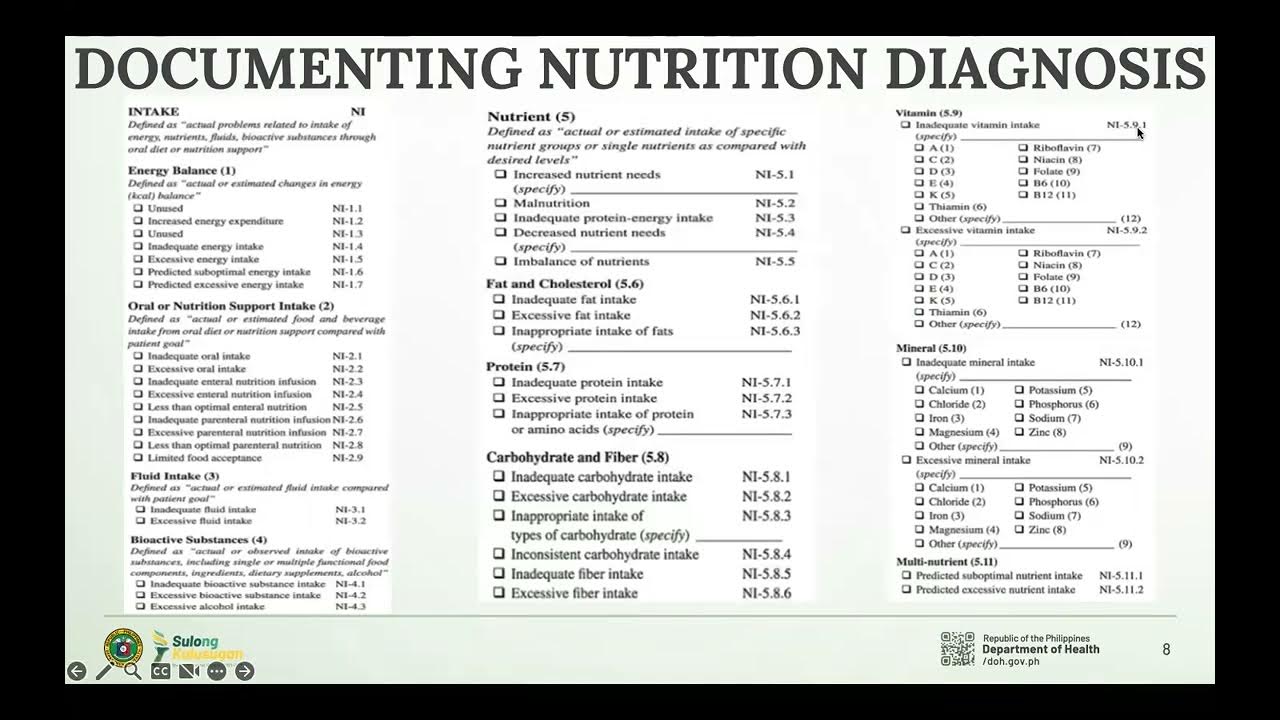7 Nutrition Screening
Summary
TLDRThis session on nutrition screening, led by Professor Lila's Africa from the University of the Philippines, covers the process of screening patients for nutritional risk. It emphasizes the importance of nutrition screening as a prerequisite to the Nutrition Care Process (NCP). The session details criteria for identifying patients at nutritional risk, various screening tools, and anthropometric measurements for both adults and pediatric patients. Special attention is given to conditions like malnutrition, weight changes, and dietary intake. The lecture also covers different screening methods for hospitalized patients, including the use of growth charts, BMI, and arm circumference measurements.
Takeaways
- 😀 Nutrition screening is essential for identifying patients at nutritional risk, especially those who are critically ill, and serves as the first step in the Nutrition Care Process (NCP).
- 😀 All hospital patients must undergo nutrition screening by nurses using a standardized tool based on patient care standards.
- 😀 Periodical screening is recommended for patients who are not initially identified as nutritionally at risk during their hospital stay.
- 😀 Nutritionally at-risk patients include those with potential or actual malnutrition, chronic diseases, or increased metabolic requirements.
- 😀 Patients at risk also include those on altered diets, receiving parenteral or enteral nutrition, or those unable to ingest or absorb food for more than seven days.
- 😀 Specific conditions for nutritional risk include significant weight loss or gain, BMI outside the ideal range, or inadequate nutritional intake.
- 😀 The nutrition screening form collects essential patient data such as age, sex, weight, height, and clinical conditions, which must be filled out accurately.
- 😀 If any nutritional risk factors are identified, the patient should be referred for Medical Nutrition Therapy (MNT) and the physician should sign the referral.
- 😀 For accurate anthropometric measurements, it is important to use the correct equipment, such as a beam balance for weight and height measurements for ambulatory patients.
- 😀 Special anthropometric measurement techniques are needed for non-ambulatory patients, using methods like ulnar length measurement for height estimation.
- 😀 Growth charts and BMI classifications are used to assess nutritional status in pediatric patients, with severe malnutrition or wasting indicated by certain z-scores or BMI thresholds.
Q & A
What is the purpose of nutrition screening?
-The purpose of nutrition screening is to identify patients who are at risk of malnutrition, including those who are critically ill, using parameters such as medical history, data intake, and critical condition. This is done to ensure proper nutrition care for the patients.
Who is responsible for conducting nutrition screening in hospitals?
-Nurses are responsible for conducting nutrition screening for all patients admitted to hospitals using a nutrition screening tool, based on standards of patient care.
What are the criteria for identifying nutritionally at-risk patients?
-Nutritionally at-risk patients are those with conditions such as involuntary weight loss, presence of chronic disease, altered diets, impaired ability to ingest or absorb food, or those receiving enteral or parenteral nutrition, among others.
What are some key signs that a patient might be at risk of malnutrition?
-Key signs include involuntary weight loss greater than 10% of usual body weight in 6 months, weight loss over 5% in one month, or being 20% over or under the ideal body weight.
What is the role of the nutrition screening tool?
-The nutrition screening tool is used to collect patient information, including details about age, sex, clinical conditions, and weight history, in order to assess the patient's nutritional status and identify any risks.
What should be done if a patient is identified as nutritionally at risk?
-If a patient is identified as nutritionally at risk, they should be referred to a registered dietitian for further assessment and Medical Nutrition Therapy (MNT).
How is height measured in ambulatory adult patients during screening?
-Height in ambulatory adult patients is measured using a beam balance or height-measuring tool, with the patient standing and ensuring their shoulders, buttocks, and heels are touching the vertical stand. The height is recorded to the nearest centimeter.
How is height estimated for non-ambulatory patients?
-For non-ambulatory patients, height can be estimated using the ulnar length, measured from the tip of the elbow to the styloid process. Conversion charts are then used to estimate the patient's height.
What are the differences between the Asia-Pacific BMI criteria and the WHO criteria for nutritional status classification?
-The Asia-Pacific BMI criteria classify overweight as a BMI of 23.0-24.9, while the WHO criteria consider it overweight only from a BMI of 25. This difference is due to higher body fat percentages in Asian populations compared to Caucasians.
What are some of the tools used to measure a child's nutritional status?
-For children under 2 years old, a mechanical weighing sling or spring balance is used for weight, while for older children, a beam balance is used. Length is measured using an infantometer for children under 2 years, and a height board for those 2 years and older.
Outlines

Cette section est réservée aux utilisateurs payants. Améliorez votre compte pour accéder à cette section.
Améliorer maintenantMindmap

Cette section est réservée aux utilisateurs payants. Améliorez votre compte pour accéder à cette section.
Améliorer maintenantKeywords

Cette section est réservée aux utilisateurs payants. Améliorez votre compte pour accéder à cette section.
Améliorer maintenantHighlights

Cette section est réservée aux utilisateurs payants. Améliorez votre compte pour accéder à cette section.
Améliorer maintenantTranscripts

Cette section est réservée aux utilisateurs payants. Améliorez votre compte pour accéder à cette section.
Améliorer maintenantVoir Plus de Vidéos Connexes

12 Nutrition Care Process Nutrition Monitoring and Evaluation

9 Nutrition Care Process Nutrition Diagnosis

C-SSRS Screener Training - English (USA)

TDC 218: COMO FAZER UM CHECK-UP - Parte 1

AML Watcher A Quick Demo | The Future of AML Compliance and AML Screening

The New Client Flow for Wellness and Recovery from Substance Related Issues
5.0 / 5 (0 votes)
